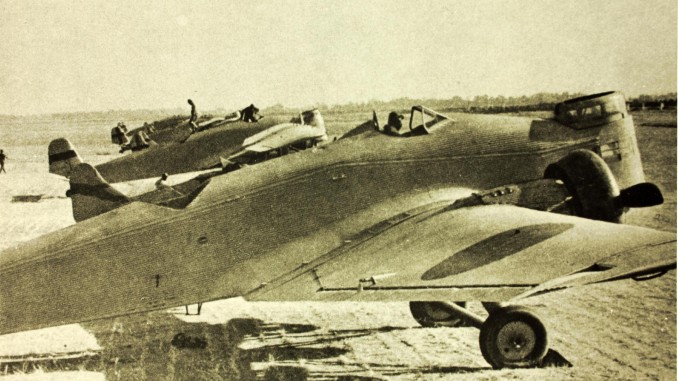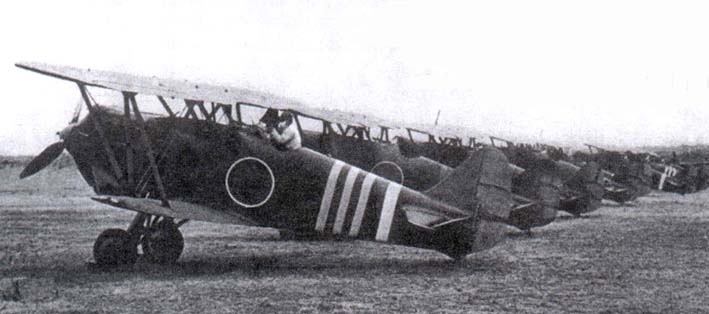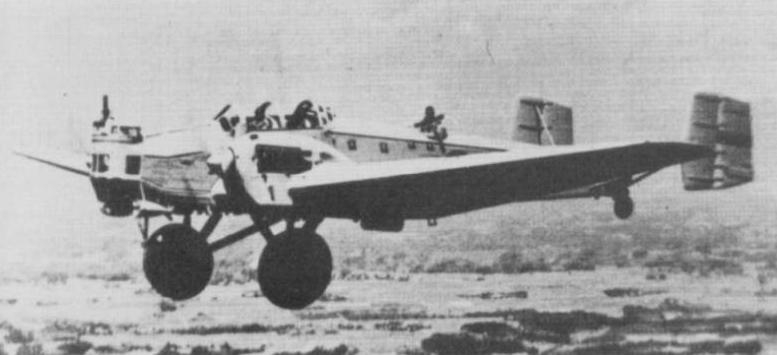
Although the “China Incident”, as the Japanese referred to the war in China, began near the old northern capital of Beijing air activity in the area was minimal compared to the central Shanghai front. Chiang Kai-Shek had deliberately kept his main fighter and bomber forces away from the area to concentrate on the threat from the Japanese naval air forces. In the north, it was the Imperial Japanese Army Air Force (IJAAF) that would carry the fight.
The IJAAF units in position from July 1937 comprised a total of 24 chutai (or squadrons), including 5 equipped with Kawasaki Ki-10 Type 95 biplane fighters and several equipped with obsolescent Mitsubishi Ki-1 (Type 93 Heavy) and Ki-2 (Type 93 Light) bombers with fixed landing gear. These aircraft would shortly be joined by Italian-made Fiat BR.20s, which would themselves be temporary stopgaps until the Mitsubishi Ki-21 (Type 97) could be produced in large numbers. The Japanese were initially based around the port city of Tianjin, not far from Beijing, both of which fell in the first fortnight of the conflict. Chinese air forces were negligible, consisting mainly of reconnaissance models supported by a handful of older Hawk II fighters, less capable than the Hawk IIIs that equipped Shanghai-based units. These were based around the city of Taiyuan, 250 miles inland from Tianjin.
Early moves
For the first few weeks of the war, the Japanese air forces were largely engaged with supporting the army as it pushed inland. The bombers hit communication links whilst the fighters strafed and bombed in front of the advancing troops. However, with such light opposition the Japanese air presence was reduced in August, with most of the chutai returning the Manchuria – just 6 remained. It was the Ki-10 fighters of the 1st Daitai, 16th Rentai which encountered the first Chinese aerial opposition on the 19th of September – a flight led by Capt Tsutomu Mizutani shot down 4 observation planes near Datong, the first ever victories claimed by the IJAAF.
A more significant engagement occurred two days later. 14 Ki-2 light bombers were dispatched to bomb the airfield at Taiyuan, escorted by 7 Ki-10s led by the commander of the 1st Daitai, 16th Rentai, Maj Hiroshi Miwa. On the way to the target a pair of observation planes were encountered and shot down, and further combat occurred as the bombers arrived at Taiyuan. Hawk IIs of the 28th Pursuit Squadron took off to intercept them, but before they could climb into the attack they were set upon by diving Ki-10s. One Hawk was shot down immediately, but a second – piloted by Capt Chan Kee-Wong, commander of the 28th – was challenged to single combat by Maj Miwa. As Miwa ordered his wingmen to remain at altitude and dived into the attack, Chan was able to evade and manoeuvre into firing position himself. Miwa’s fighter was riddled with bullets and crash landed, the pilot mortally injured. His wingman avenged their fallen comrade by shooting down Chan in turn, the Chinese pilot was more fortunate than his adversary as he survived the action, albeit with injuries that ended his flying career. In total the Japanese claimed to have shot down 5 Chinese aircraft, with Miwa representing the only loss.
This combat clearly highlighted the changing nature of air combat. Miwa had anticipated getting into a close quarters dogfight, and chose to give up the advantage in numbers by having his wingmen support him. In this instance Chan proved the more capable dogfighter and was able to get the better of his opponent. As the war progressed, the utility of close quarters dogfighting would prove to be extremely limited. Diving attacks with altitude advantage would prove to be one of the keys to successful fighter combat.
Air combat was sporadic for the rest of the year. During a return trip to Taiyuan on the 1st of October, two Chinese aircraft including a Hawk were shot down. At Baoding on the 6th, a trio of Ki-10s managed to corner an A-12 Shrike and shot it down. More victories followed on the 15th, as the Japanese encountered opposition over Xinxian. Chinese aircraft were more often claimed destroyed on the ground, as Japanese bombers continued to mount bombing raids on airfields. Yangquan airfield was a common target, with many attacks launched in late October and early November that ground down the Chinese fighter and reconnaissance units in the area. The Chinese, for their part, made a game attempt to ferry some replacements into the area but suffered losses in the attempt. A flight of four Hawk IIIs led by Capt Liu Chui-Kang tried to fly into Taiyuan in late October but encountered difficult weather conditions as darkness descended on them. Liu was killed after he hit a tower in Taiyuan, whilst two of his wingmen crash-landed but survived.
Supplies from the south
Taiyuan itself fell to Japanese forces on the 9th of November, and attention turned to the stopping points on the supply route from the south. This operation received welcome reinforcements on the 11th of November as the very first prototype Mitsubishi Ki-21 Type 97 bombers arrived. These were much more capable than the old Ki-1 and Ki-2 models, being much faster, better armed, and capable of carrying a larger bomb load. The Type 97s were first used in a very effective surprise attack on Luoyang, far to the south of the front line. Several aircraft were claimed damaged on the ground and the escorting Ki-10s claimed an O2U Corsair observation plane as it attempted to take off during the attack. This success was followed by another at Changan airfield where more Chinese planes were damaged.
The Ki-21s were joined in their attacks by Navy G3M Type 96s from the end of November. Chinese reinforcements were spotted at airfields on the main supply routes from Soviet Russia, and since the IJAAF bombers lacked the range to strike them a request was made for the longer range Navy aircraft. Consequently the Kisarazu Ku moved from Cheju-Do to Yangquan airfield on the 16th of November. The rikko were first used against Zhoukou airfield in a raid on the 21st, where they caught a new consignment of I-16 fighters on the ground. Col Kao Chi-Hang, one of the heroes of 814 Day, was killed by a bomb that exploded near his parked aircraft. A repeat raid the next day cost the Kisarazu a bomber shot down, but was followed by a series of attacks on Luoyang airfield which was within range of Ki-10 fighters. Consequently these proved escorts for the G3Ms. The raids on Luoyang were considered ‘most successful’ with dozens of aircraft being damaged and destroyed on the ground. Follow on raids against Xian airfield and the Kungshien arsenal were also effective.
To conclude their tour in northern China, the G3Ms were sent on a series of raids against Lanzhou, deep in the Chinese interior, during December. These flights of 1,500 miles required crossing the Qilian Mountains to reach the city, a difficult task because the bombers were not fitted with adequate high-altitude oxygen systems. The crews suffered accordingly, reporting headaches and nausea from the oxygen deprivation. Maps of the area were inadequate, navigators were provided with pages of a boy’s magazine that showed the city in lieu of military standard maps. Results were mixed, with a raid on the 4th causing no damage to aircraft on the ground. However, a follow up attack on the 13th succeeded in destroying a pair of giant Russian TB-3 bombers and damaging two more.
With a foothold firmly secured in northern China, IJAAF units began to relocate to the Central China front around Shanghai. The 8th Daitai began to make the move in mid-November. There they would join the IJNAF in attack Nanking, where they would encounter a new enemy: pilots of the Soviet Volunteer Group. In fact, remaining Ki-10s from the 2nd Daitai would encounter Soviet I-15s over Luoyang on the 22nd of January 1938, as the Chinese Air Force began to rebuild with fresh men and machines from their new ally.
Sources:
Håkan’s aviation page: http://surfcity.kund.dalnet.se/sino-japanese-1937.htm
Japanese Army Air Force Units and Their Aces 1931-1945, Christopher Shores, Ikuhiko Hata, Yasuho Izawa
Japanese Monograph JM-76: IJAAF Operations in China Area 1937-45




Leave a Reply